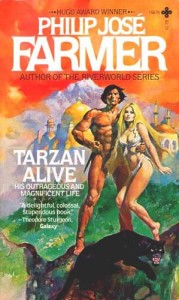 Mention the name of Tarzan and most people think of the brawny hero of a series of B-movies made in the ’30s and ’40s. Elmo Lincoln was the first actor to portray the so-called “Ape Man” way back in 1918, a mere five years after the publication of the first of Edgar Rice Burroughs’ books! Lincoln was followed by a succession of actors, including Johnny Weismuller, Buster Crabbe and Lex Barker. Each of these films showed a well-built man in a loincloth, honorable and heroic, more comfortable in the jungle than in society. His image was updated, and more finely drawn in later films and television programmes. Ron Ely’s TV Tarzan from 1966-67 certainly modernized him, but kept the beefcake image. 1984’s Greystoke was an attempt to be faithful to Burroughs’ books, but ultimately failed because the historical image created by the earlier films was stronger than the impression made by the source material.
Mention the name of Tarzan and most people think of the brawny hero of a series of B-movies made in the ’30s and ’40s. Elmo Lincoln was the first actor to portray the so-called “Ape Man” way back in 1918, a mere five years after the publication of the first of Edgar Rice Burroughs’ books! Lincoln was followed by a succession of actors, including Johnny Weismuller, Buster Crabbe and Lex Barker. Each of these films showed a well-built man in a loincloth, honorable and heroic, more comfortable in the jungle than in society. His image was updated, and more finely drawn in later films and television programmes. Ron Ely’s TV Tarzan from 1966-67 certainly modernized him, but kept the beefcake image. 1984’s Greystoke was an attempt to be faithful to Burroughs’ books, but ultimately failed because the historical image created by the earlier films was stronger than the impression made by the source material.
If you have read any of the twenty-four books in the Tarzan series, you know that Lord Greystoke was fluent in several languages: French, English and the language of his simian family. He spent almost equal time (after being “rescued” from the jungle) in a tuxedo as he did in the jungle. And he never swung through the trees on vines!
Well, you do not have to read the two dozen Burroughs’ classics, although I recommend that you do (they are pure entertainment); instead you can read Philip Jose Farmer’s biography of Tarzan, called Tarzan Alive. Farmer describes Lord Greystoke in his original foreword as “a living person.” This is a biography, not of the author of the books, but of the main character. Farmer condenses and organizes the major events of Tarzan’s life into chronological order, and makes the same kind of judgments as any biographer might. This new edition also includes an interview with Lord Greystoke, from a meeting “in a motel near Chicago” as well as “Extracts from the Memoirs of ‘Lord Greystoke’,” which Farmer published in 1974.
Nothing can really replace a leisurely reading of the original books. You must read at least the first three (Tarzan of the Apes, The Return of Tarzan, The Beasts of Tarzan) to get the basic story and appreciate the levels of cultural and philosophical questions which Burroughs dealt with. It’s a lesson in cultural bias from the Victorian Age to today! Farmer touches on these points, but it’s more enlightening to read them in the original.
Farmer does a fine job of consolidating all the material. He leaves the reader with a three dimensional portrait of the main characters, their foibles, and motivations. Of course most of his time is spent on the “Ape Man” himself, but Tarzan is the most interesting character anyway. Farmer traces his ancestors and makes great characters of fiction into flesh and blood relatives of the Greystoke line. Included are literary icons like Sherlock Holmes, Doc Savage, the Scarlet Pimpernel and Nero Wolfe. What a bloodline it was indeed!
For an introduction to one of the most resilient heroes in literature, Tarzan Alive is a remarkable offering. Disney is readying an all-singing, all-swinging Tarzan for Broadway right now. The time is right for an all out revival, and Farmer’s book is a fine place to start. But please don’t finish here. Go on to read the originals, put your modern political correctness on hold, and spend some time with the untamed, terrible ape man himself — Tarzan!
(Bison Books, 1972)
